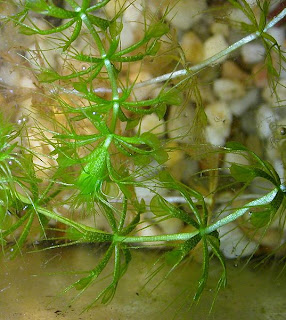Carnivorous plants are plants that originated some or most of their nutrients (but not energy) from trapping and consuming animals or protozoans, typically insects and arthropods.
Carnivorous plants seem to adapt to grow in places that thin or poor soil nutrients, especially nitrogen, such as acid swamp and rock outcroppings. Charles Darwin wrote of Plant-eating insects, the first known treatise on carnivorous plants, in 1875.
Aldrovanda Vesiculosa

Aldrovanda vesiculosa, known as the waterwheel plant, is the only extant flowering plant species in the genus Aldrovanda of the family Droseraceae. This plant feeds on small water invertebrates using a trap that is very similar to those of the Venus flytrap. The traps are arranged in whorls around the stem, the center of free-floating, hence the common name. This plant is one plant that is able to plant some fast movement.
Iinoflora Byblis
![]()
liniflora Byblis is a species of carnivorous plants in Byblidaceae family. It is found in Australia, Indonesia, and Papua New Guinea
Cepchalotus
Cephalotus is a genus containing one species, Cephalotus follicularis, a small carnivorous pitcher plants. The-hole modified trap falling leaves have inspired the common name for this plant, which includes the Albany Pitcher Plant, West Australian Pitcher Plant, plants or plant fly-catcher mocassin.
Urticularia
Utricularia are plants with the fastest motion. Plants that live in water are carnivorous plants, the kind who suck small animals to obtain nutrients, just like sac semar and Venus that trap insects.
How quickly these plants move in search of prey? Scientists from the University of Grenoble in France found that to suck prey, these plants only need 1 / 2 milliseconds, much faster than Venus who takes 100 milliseconds.
Carnivorous plants seem to adapt to grow in places that thin or poor soil nutrients, especially nitrogen, such as acid swamp and rock outcroppings. Charles Darwin wrote of Plant-eating insects, the first known treatise on carnivorous plants, in 1875.
Aldrovanda Vesiculosa

Aldrovanda vesiculosa, known as the waterwheel plant, is the only extant flowering plant species in the genus Aldrovanda of the family Droseraceae. This plant feeds on small water invertebrates using a trap that is very similar to those of the Venus flytrap. The traps are arranged in whorls around the stem, the center of free-floating, hence the common name. This plant is one plant that is able to plant some fast movement.
Iinoflora Byblis
liniflora Byblis is a species of carnivorous plants in Byblidaceae family. It is found in Australia, Indonesia, and Papua New Guinea
Cepchalotus
Cephalotus is a genus containing one species, Cephalotus follicularis, a small carnivorous pitcher plants. The-hole modified trap falling leaves have inspired the common name for this plant, which includes the Albany Pitcher Plant, West Australian Pitcher Plant, plants or plant fly-catcher mocassin.
Urticularia
Utricularia are plants with the fastest motion. Plants that live in water are carnivorous plants, the kind who suck small animals to obtain nutrients, just like sac semar and Venus that trap insects.
How quickly these plants move in search of prey? Scientists from the University of Grenoble in France found that to suck prey, these plants only need 1 / 2 milliseconds, much faster than Venus who takes 100 milliseconds.


No comments:
Post a Comment